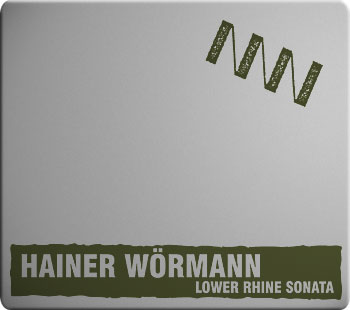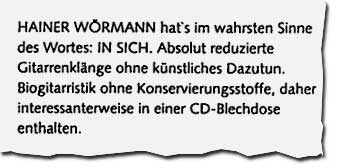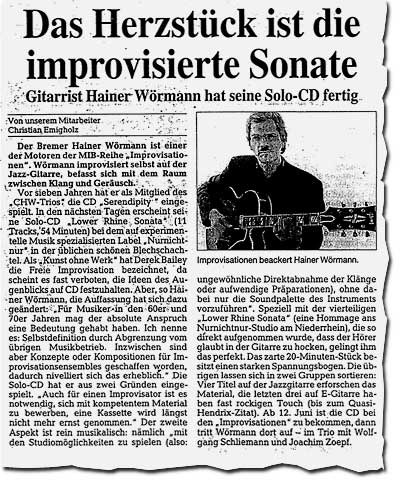
1 Part 1 PA 4:04
2 Part 2 TREEPIECES 5:02
3 Part 3 TIC 3:09
4 Part 4 HO 7:33
5 EBOWCROW 7:15
6 BRUSHES 3:25
7 STYRO 2 5:48
8 PIBROCH 7:17
9 YELLOW 2:26
10 CORCSTONE 2:35
11 ECHINACEA 3:54
Total Time 53:44

Revelation 18

Kurier am Sonntag, Bremen, 3.6.2001
Den vergleichsweise kreativsten und damit auch im besten Sinne musikalischsten Umgang mit den genannten Materialien präparierter Gitarrenkunst pflegt am heutigen Spieltag in der deutschen Liga HAINER WÖRMANN auf seiner "Lower Rhine Sonata" (NNN - LC 05245 - Berslton 1001003). Sowohl auf der Akustischen wie auf der Elektrischen erweist sich Wörmann als vielseitiger Klangpoet, dessen Ausdrucksbreite von virtuos-filigranem Flageolet-Picking bis zu E-Bow-unterstützten Feedback-Expressionismen, von zupackenden Noise-Attacken bis hin zu fast orientalisch anmutenden Melodiebögen reicht. Hier wird nicht auf Effekten herumgeritten, sondern hier wird - auch wenn sich der Ausdruck altmodisch und abgegriffen anhören mag - aus Effekten mit Herz und Hirn gestaltet.
Bad Alchemy 40
The basic instrument of Hainer Wörmann on this CD is the guitar. As it is
usual with the releases of NurNichtNur, the instrument is used as a medium for
improvised music. Also in this case, Hainer plays several kinds of guitars and
results are recorded without the use of any electronics to change the sound.
He plays his guitars in an unconventional way using some tools as a brush, wooden
sticks, styrofoam. This creates of course a variation in sounds going from short
tunes as plucking the snare still rustle. A large variation in music and tunes
is created with other words depending which tool is used and if it is a classic
guitar or an electric version. Again a pure improvisation release from NurNichtNur
with a large variation in the tracks sometimes difficult sometimes easy. The
united sound of guitar. The release is located in a beautiful tin box with a
little printed leaflet inside.
Geert De Decker at Sztuka Fabryka
The CD is arranged into three sections, each comprising three or four tracks. The first is the most stripped-down; Wormann attacks the strings with, in turn, what sound like a comb, an irregularly-shaped piece of plastic, a metal slide or similar object, and a length of metal with a sharp edge. When listening to music Iike this one is reminded of electronic music, which often proceeds from a similar premise but is less frequently criticised for doing so. These pieces are best described as deliberately directionless explorations of specific sonic territories.
The same approach is taken in the central two pieces of the second segment - brushes and styrofoam, this, time, and again to surprises for anyone who has experimented in this area before. Still, in all of these pieces there is an audible intelligence at work which makes some sense of the proceedings even if a certain musical chutzpah is missing; it takes a great deal to take sounds Iike the4se and make virtuosic music from them, a lot less to simply present them as they are.
These pieces are flanked by E-Bow improvisations
which this writer found far more satisfactory, perhaps because there
is something familiarly linear to hang onto. Wormann is forced by his
chosen
technique to develop along a straight line and the discipline has him
wringing fine music from his Instrument "Ebowcrow" imitates saxophone
multiphonics rather impressively; "Pibroch" might äs well
be an hommage to Robert Fripp, although it probably isn't.
The final three pieces make expensive use of the distortion pedal. Although it's
an effect which has been under-utilised by experimental guitarists, there's not
much here that isn't already in Sonny Sharrock's work. That said, there's something
more fearsome about Wormann's playing, and of course his wider repertoire of
preparations and tools gives him a few more options. In some ways these are the
most impressive pieces here because they move away from the techniques and into
making music with them.
It is not this writer's intention to give the impression that these are bad records.
They are not, but they are a little presumptuous. We have heard music of this
sort many tirnes before, and in more congenial contexts. Both Wissel and Wormann
require some Stimulation - either Company or some more rigorous ideas - to keep
their music sharp.
Richard Cochrane
Musings 6/02